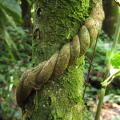
DMT-Nexus member

Posts: 14191 Joined: 19-Feb-2008 Last visit: 22-Nov-2025 Location: Jungle
|
As I mentioned earlier in this thread, 2MTHBC is also found in chacruna and therefore ayahuasca brews, and tests have shown no toxicity from regular long term ayahuasca use.. Now of course we need to question dosages, gotta check how much in % its there in the phalaris you want to test, compared to ayahuasca..
I think gramine is more something to worry about.
|
|
|
|
|

DMT-Nexus member
Posts: 1453 Joined: 05-Apr-2009 Last visit: 02-Feb-2014 Location: hypospace
|
this betacarboline is associated with DMT containing species and is the betacarboline analog of DMT itself
One should be able to produce this chemical by employing a Pictet Spengler reaction on DMT, something typically requiring heat, a Lewis acid and aldehyde.
This betacarboline might be an artifact of hot acidic extractions, or perhaps it is present in the plant, however it might not be as soluble as DMT, typical exactions that result in traces of this alkaloid may not be ideal for it and may only be recovering a small portion of the molecule present in the basic or caustic solution.
This betacarboline may also oxidize.
It should have a glow under uv, unlike DMT, so if it did occur in DMT the material would glow in a visible spectrum under a black light. DMT is fluorescent, but not in a visible spectrum.
I would expect that this alkaloid, 2MTHbC, would also be colored, and would discolor DMT if it occurred in it.
I wish there was more data about central effects of this molecule. It occurs in nature in DMT containing plants and has been known as a contaminant product in DMT synthesis.
What are the sizes of the breakdown products of this molecule, what does it fracture into and how does it's molecular weight and melting point differ from DMT?
edited to add this :
2-Methyl-1,2,3,4-tetrahydro-�-carboline (4), white
shiny needle crystals (MeOH) (50 mg), mp 213 ∞C,
UV λmax (MeOH) nm 290, 294. EIMS, m/z (rel.
int.): [M+] 186 (26), 171 (6), 144 (100), 143 (63),
115 (10), 94 (5), 77 (4), 42 (4).
|
|
|

DMT-Nexus member
Posts: 1453 Joined: 05-Apr-2009 Last visit: 02-Feb-2014 Location: hypospace
|
the following may relate to this discussion: Quote:Acacia obtusifolia has apparently been reported to contain variable amounts of bufotenine in the resin extracted from the stembark. In the four samples where it was reportedly observed, it was as a minor component that appeared to be highest in a winter extract compared to the faint traces in a summer extracts (using gc-ms.) (Trout 2005)
This appears to be the first report of bufotenine in an Acacia species. It was not corroborated by a second worker's gc-ms but this was thought to be possibly due to lack of appropriate column equilibration. The presence of bufotenine was more recently confirmed in 2005 by Ott using tlc with known reference material according to a friend who was visiting him when this occurred. (Anonymous in personal communication)
Betacarboline(s) are thought have been observed in the root bark (suggested by fluorescence and bioassay results in summer of 2003) but there was no attempt at identification.
One stem bark alkaloid was thought to possibly be 1,2-dimethyl-1,2,3,4-tetrahydro-β-carboline based on the second worker's gc-ms mentioned above but the identity was never actually established. (Trout 2005)
Earlier hplc-ms work by Mulga appears to have also observed a betacarboline in the stem bark but it was not identified.
Mulga did not observe bufotenine. (Mulga 2005) then there are these from Anadenanthera: Quote:1,2,3,4-Tetrahydro-6-methoxy-2,9-dimethyl-beta-carboline,
1,2,3,4-Tetrahydro-6-methoxy-2-methyl-beta-carboline, Also reported is 2-methyltryptoline, which is another name for the molecule that is the title of this thread
|
|
|

dysfunctional word machine

Posts: 1831 Joined: 15-Mar-2014 Last visit: 26-Mar-2025 Location: at the center of my universe
|
2-methyl-tetrahydro-beta-carboline (2M-THBC) is also named 2-methyl-tetrahydro-norharmane and 2-methyl-tryptoline. The alleged neurotoxicity of 2M-THBC is due to some degree of strctural similarity with the MPTP molecule. This molecule is infamous as the result of a failed synthesis of a pethidine analog. Users of the MPTP polluted product developed acute symptoms of Parkinson's disease. The MPTP itself is not neurotoxic, but in the body it is oxidized into MPP+, which kills certain dopaminergic brain cells. The allegations of possible neurtoxicity of 2M-THBC assume that it is oxidized in the body into 2-methyl-dihydro-betacarbolinium (2M-DHBC), and that the latter compound would exhibit similar neurotoxicity as MPP+. The attached images show the difference between 2M-THBC and 2M-DHBC: in the latter molecule the 1 and 2 hydrogens have been oxidized off and the 2-Nitrogen is quaternized. pitubo attached the following image(s):  2mthbc-label.png (5kb) downloaded 218 time(s). 2mdhbc+-label.png (5kb) downloaded 219 time(s).
|
|
|

dysfunctional word machine

Posts: 1831 Joined: 15-Mar-2014 Last visit: 26-Mar-2025 Location: at the center of my universe
|
More on the allegations of neurotoxicity: Wikipedia, in its lemma on Tryptoline states that "There is evidence that tryptolines may be potent neurotoxins that may play a role in Parkinson's Disease" and then references that with an article that makes no such statements at all... The article is: Pharmacological properties of tetrahydronorharmane (Tryptoline)H. Rommelspacher, H. Kauffmann, C. Heyck Cohnitz, H. CoperNaunyn-Schmiedeberg's Archives of Pharmacology June 1977, Volume 298, Issue 2, pp 83-91 http://dx.doi.org/10.1007/BF00508615Back to the 2-N-methylated beta-carbolines that are subject of this thread. Here is an example of an article that runs off with the MPP+ theme, handwaves about that beta-carbolines could well be the endogenous cause of Parkinsonism, but proves nothing about actual in vivo neurotoxicity and admits in conclusion that beta-carboliniums are not comparable to MPP+: Mitochondrial respiratory inhibition by N-methylated beta-carboline derivatives structurally resembling N-methyl-4-phenylpyridine.R Albores, E J Neafsey, G Drucker, J Z Fields, and M A Collins Proc Natl Acad Sci U S A. 1990 Dec; 87(23): 9368–9372. http://www.ncbi.nlm.nih.gov/pmc/articles/PMC55166/Finally, an article from 1993 that analyses post mortem brain tissue without lesions or other irregularities associated with Parkinsonism or other forms of neurodegeneration. In normal brain tissue, N-methylated beta-carbolines and beta-carboliniums are found: Potential bioactivated neurotoxicants, N-methylated β-carbolinium ions, are present in human brainKazuo Matsubara, Michael A. Collins, Atsushi Akane, Jun Ikebuchi, Edward J. Neafsey, Masato Kagawa, Hiroshi ShionoBrain Research Volume 610, Issue 1, 30 April 1993, Pages 90–96 http://dx.doi.org/10.1016/0006-8993(93)91221-D
|
|
|

Communications-Security Analyst
Posts: 1280 Joined: 17-Aug-2014 Last visit: 27-Aug-2025 Location: Nirvana
|
The idea of endogenous MTHC is rather fascinsting since it's a co product of many different synthetic routes to DMT.
|
|
|

dysfunctional word machine

Posts: 1831 Joined: 15-Mar-2014 Last visit: 26-Mar-2025 Location: at the center of my universe
|
To quell even more paranoia about harmalas and MPTP: http://onlinelibrary.wiley.com/...4159.2000.0750521.x/fullProtective Effect of Harmalol and Harmaline on MPTP Neurotoxicity in the Mouse and Dopamine-Induced Damage of Brain Mitochondria and PC12 CellsChung Soo Lee, Eun Sook Han, Yoon Young Jang, Jeong Ho Han, Hyun Wook Ha, Doo Eung Kimdoi: 10.1046/j.1471-4159.2000.0750521.x Abstract:The present study elucidated the protective effect of β-carbolines (harmaline, harmalol, and harmine) on oxidative neuronal damage. MPTP treatment increased activities of total superoxide dismutase, catalase, and glutathione peroxidase and levels of malondialdehyde and carbonyls in the basal ganglia, diencephalon plus midbrain of brain compared with control mouse brain. Coadministration of harmalol (48 mg/kg) attenuated the MPTP effect on the enzyme activities and formation of tissue peroxidation products. Harmaline, harmalol, and harmine attenuated both the 500 μM MPP+-induced inhibition of electron flow and membrane potential formation and the 100 μM dopamine-induced thiol oxidation and carbonyl formation in mitochondria. The scavenging action of β-carbolines on hydroxyl radicals was represented by inhibition of 2-deoxy-d-ribose degradation. Harmaline and harmalol (100 μM) attenuated 200 μM dopamine-induced viability loss in PC12 cells. The β-carbolines (50 μM) attenuated 50 μM dopamine-induced apoptosis in PC12 cells. The compounds alone did not exhibit significant cytotoxic effects. The results indicate that β-carbolines attenuate brain damage in mice treated with MPTP and MPP+-induced mitochondrial damage. The compounds may prevent dopamine-induced mitochondrial damage and PC12 cell death through a scavenging action on reactive oxygen species and inhibition of monoamine oxidase and thiol oxidation.
|
|
|

DMT-Nexus member
Posts: 1111 Joined: 18-Feb-2017 Last visit: 12-Jul-2024
|
I'm wondering if I have just experienced 2MTHBC.
I did vinegar saltings on old naphtha I had used in the extractions of MHRB, Phalaris and Acacia floribunda with freeze precipitation.
I ingested ~30 mg of the resulting acetates, with 200mg harmine (possibly with some harmaline contamination). The effects were reminiscent of high dose harmaline - lightheadedness, but also pressure around and above my eyes, perhaps something like sinus pressure. It wasn't pleasant, but it wasn't too bad, and it lasted for ~4-6 hours.
I did this bioassay twice, with the same results.
I first thought it was the harmaline contamination, but I had taken that harmine batch before without those effects, and it would have had to be a really strong dose of harmaline (at least 100 mg, perhaps 200 mg) to produce such lightheadedness. So now I suspect it was something from the naphtha washes.
The phalaris and A. floribunda extractions were relatively small, but the MHRB was 100g. Assuming 2% DMT in MHRB and an 2MTHBC content of 3% that of DMT, that would have been 2g DMT and 60mg 2MTHBC. The salted-out acetates were ~60mg. If naphtha pulls 2MTHBC, but it doesn't freeze precipitate, then the saltings would have contained ~60mg worth of freebase 2MTHBC, which would have been close to what I obtained?
Had anyone else bioassayed saltings of their freeze-precipitated naphtha?
|